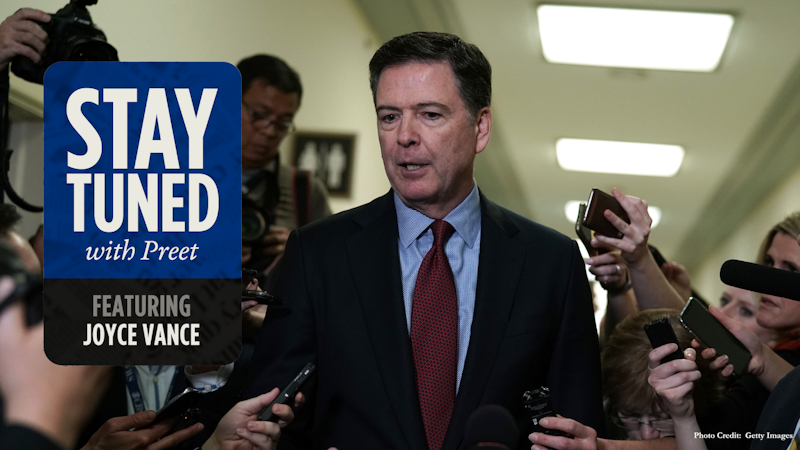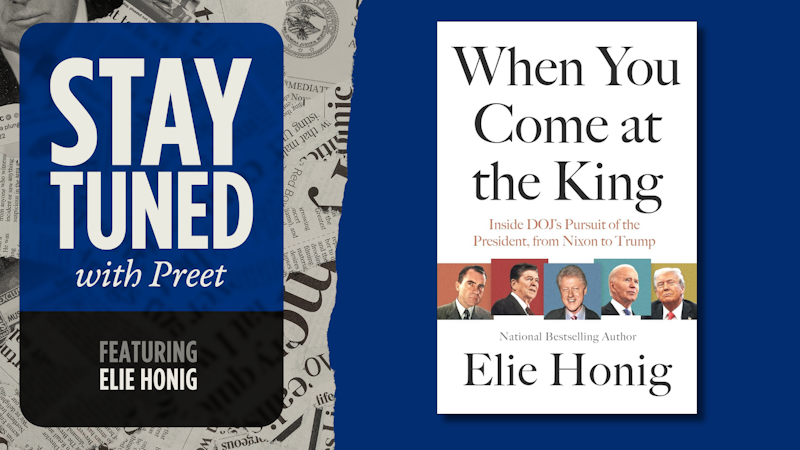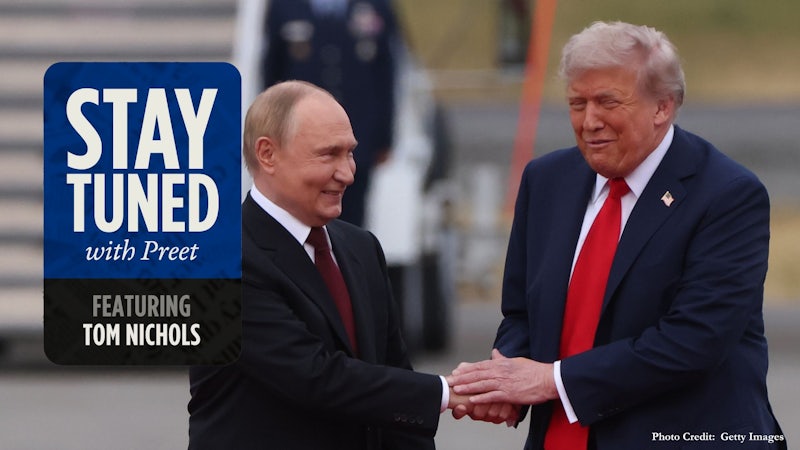Preet Bharara:
From CAFE and the Vox Media Podcast Network, this is Stay Tuned In Brief. I’m Preet Bharara. Donald Trump is now a convicted felon. On Thursday, 12 New Yorkers decided the former president was guilty on all 34 counts of falsifying business records in a historic verdict. It wasn’t a judge or a prosecutor or a political adversary who made this decision. It was a jury of Trump’s peers. Juries are an essential part of our justice system, but what exactly is their function? What do deliberations actually look like, and how can the public trust that they are impartial? Given the unprecedented nature of this trial and verdict, it’s important to understand what really goes on inside a jury room. Before the verdict was announced, I was joined by Shari Seidman Diamond, a professor at the Pritzker School of Law at Northwestern, and a research professor at the American Bar Foundation. She’s one of the country’s foremost experts and researchers on the jury process. Professor, welcome to the show.
Shari Seidman Diamond:
Glad to be here.
Preet Bharara:
May I start with a very basic question, which is explain why we have a system in which lay people, ordinary people who are not schooled in the law, are not experts in any way, why do they sit in judgment in criminal cases in this country?
Shari Seidman Diamond:
Well, they’re the essential democratic institution. They’re us, and these are very important and difficult questions that we give to them. And they are the ones who reflect what is good and bad about us.
Preet Bharara:
Is there a better system?
Shari Seidman Diamond:
Some people have argued that you get a better system if you have professionals, and of course there are some countries that do not have juries. There are other countries that have mixed tribunals, which consist of professional judges and laypeople sitting together. But the laypeople bring to the system a kind of common sense understanding and a much wider range of experience than what professional judges can bring.
Preet Bharara:
Right, and the judgment of the community, I suppose. One thing people should appreciate that at least in the federal system, defendants can waive their right to a jury. We have the constitutional right to one, but they can waive that right like they can waive other rights including the right against self-incrimination. And in my experience at the Southern District and otherwise, very few defendants choose to waive that right. Is that a sign that generally speaking, the defense bar and defendants themselves view the jury system as their fairest shot?
Shari Seidman Diamond:
Yes. And actually we’ve done some surveys of attorneys across the country, and that is actually the way attorneys, both civil and criminal, see the jury. As fairer than a bench trial, fairer than arbitration. So that is a similar response.
Preet Bharara:
What’s your understanding based on years of research as to how we can be sure or pretty confident, if we can be, that jurors in a high profile case like the Trump case or in any other garden-variety case, that they are taking their responsibility seriously and with sobriety and are paying attention to all the instructions they’re given by the judge?
Shari Seidman Diamond:
Well, there are two parts to that question. They take their responsibility pretty seriously, and I think we’ve seen some evidence of that in the Trump trial in terms of the questions that they’ve asked and the efforts that they made during the trial, apparently taking notes and so forth. So that part is something that we see even on minor trials and trials involving sort of simple auto accidents, jurors take their jobs very seriously. You ask a second question, which is about do they pay attention to and use the jury instructions? And the common view is that the jury instructions are a challenge for them, and I absolutely agree with that, but they also spend a good deal of time trying to understand them.
One of the peculiar things about the Trump trial is that the jury has not been given a copy of the 55-page jury instructions. That is the norm in state court in New York. It is not the norm in other places. According to the study by the National Center for State Courts, about 78% of state trials give the jurors a copy of the instructions. And the better practice, which I’ve seen in research that we’ve done on Arizona juries, is that you give each juror a copy of the instructions. And that happens in 43% of the states.
Preet Bharara:
I don’t understand the theory behind the law or practice of not giving the jury instructions to the jury. Obviously, it’s very important. They’re instructed to pay attention to them. The lawyers say the same thing. They’re complicated, they’re lengthy. They can have them read back anytime they want. What’s the conceivable basis for not allowing them to have it?
Shari Seidman Diamond:
So I think the argument that I’ve heard, and I’m on the same page with you, I think it’s absurd not to give them a copy of the jury instructions. And when we’ve studied actual deliberations in civil cases, we find that the jurors use the instructions in the course of their deliberations and they use it to correct each other if somebody makes us a mistake in talking about the instructions and they refer to the instructions themselves. The argument that has been made in the past is the idea that they don’t want the jury to focus on one instruction to the exclusion of all other instructions. But actually, they don’t do that. They look at the instructions and they do take into consideration the bulk of the instructions when they’re given copies of them.
Preet Bharara:
Can you sketch out, based on your interviews that have been extensive, what goes on in a jury room? It’s a black box for a lot of people, including for me. Even though I’ve been a lawyer a long time, I’ve never served on a jury. And obviously, the lawyers to the parties are not permitted in the jury room, and in our office, we had a tradition of not speaking to jurors after there was a conviction. What are the various scenarios that could unfold? Do they take a straw vote right away sometimes? Do they go methodically through the counts? Do they go chronologically? Do you have some sense of what the patterns are?
Shari Seidman Diamond:
Well, there are two types of juries that people have identified. They’re crude categories, but they kind of track what you just said. That is there are juries that go back and begin by taking a straw poll and seeing where they stand and then moving toward resolving the differences in that direction. In more complicated cases, and actually best practice is for the jurors to be what we call “evidence-driven”. And that is where they review the evidence and figure out what they think happened that led them to be in the court that day, and then go to deciding how they will vote in the case.
But what we’ve seen in the actual deliberations is an interesting pattern, which is there is frequently a call for a vote at the beginning, but a call for a vote is not the same thing as a completed vote. And most of the time, the call for the vote gets derailed by somebody raising a question, by somebody saying they aren’t sure at this point, by somebody saying that they want to discuss the piece of evidence or the instructions. And so the initial vote call doesn’t what we would call “succeed” in resulting in a vote.
Preet Bharara:
And typically speaking, is there a lot of argument? Are people respectful? Does it depend from matter to matter? What’s the overall level of harmony? Or is it all like 12 Angry Men?
Shari Seidman Diamond:
Well, it’s not at all like 12 Angry Men.
Preet Bharara:
Okay. That’s a good flick. Well, hopefully it’s not 12 men anymore.
Shari Seidman Diamond:
Well, that’s true. That is absolutely true. The deliberations are, I would say for the most part they tend to be respectful. But that doesn’t mean that there isn’t anguish and dismay when somebody disagrees with you and that people don’t get angry during the course of deliberations. Like any group trying to solve a problem, if you think somebody disagrees with you for reasons that don’t make sense, you may get annoyed. And juries are no different in that respect.
Preet Bharara:
Is there such a thing, you may not like this question, but I’m going to ask it anyway. Is there such a thing as a sort of prototypical ideal juror for the defense and a different ideal juror for the prosecution and yet a different ideal juror from the perspective of neutral justice?
Shari Seidman Diamond:
I was going to say immediately until you got to your third category that it varies from case to case, and there are all sorts of ways in which a juror who votes for the defense ultimately might come to that viewpoint depending on the case. But you added that third question.
Preet Bharara:
That’s the real question. For the public to want, society to want, and the rule of law to desire jurors who you don’t know. Are they going to be more likely to vote for the defense or the prosecution? Well, that makes no sense because they haven’t heard the case yet. So the idea of a juror favorable to one side or the other before the admission of any evidence is kind of a bad thing. But as a society who wants to make sure the rule of law is followed, what kinds of people should we hope are on juries?
Shari Seidman Diamond:
Open-minded people, people who will listen to the evidence. And one of the interesting things about jury selection is that although the parties are aiming at eliminating jurors who are likely to be unfriendly to them, the general idea is that if those ends of the distribution are removed, that you will lead people on the jury who are more open-minded and less extreme as they come into the courtroom. Now, that’s the ideal. And how it works in practice is of course a different thing, but the judge’s obligation is to make sure that there is enough questioning of jurors so that an exercise, a removal for cause for bias can take place. And that the parties have enough information to make reasonable selections when they have that limited number of potential jurors they can remove.
Preet Bharara:
So I’ve talked about this a number of times on the podcast, but now I have an expert. What is your view of how two lawyers on this jury, even though they’re not practicing criminal lawyers, the existence of two lawyers on this jury, how that affects the dynamic and who that might favor?
Shari Seidman Diamond:
So it is very interesting. We did some research on the composition of juries, and the idea is usually, “Oh, well, anybody who is likely to have any expertise is going to be eliminated. You’ll never get a doctor or a nurse in a medical malpractice case, and you’ll never get lawyers on any case.” And that actually just doesn’t turn out to be true.
Preet Bharara:
Well, there’s so many damn lawyers in Manhattan, that’s why.
Shari Seidman Diamond:
Well, I have a different theory about that. What we learned is that each side who retains a juror who has some expertise in that area thinks that they have the better side of the case, and that if they have a juror on the jury who has expertise, their argument will be winning. So I think in this case, there were two lawyers and there were arguments that maybe a lawyer would be more favorable to the defense, and there were also arguments that a lawyer would be more favorable to the prosecution, so they got left on.
Preet Bharara:
It’s very odd, right? There’s a minor conflict between that dynamic and what we were talking about earlier, which is the general conception and presumption that a trial by jury is better than trial by judge. So the expertise maybe is a problem, but I guess we’ll see when they all write their books. So you’ve also done research about what is effective. Two questions. One, what are the mistakes that the parties make in jury selection that are common in understanding the psychology of people that they’re interviewing briefly and for the first time? And what are the mistakes that people make in terms of how they present evidence to a jury of ordinary people?
Shari Seidman Diamond:
Well, I think jury selection is very hard. It’s very hard to suss out how somebody is going to decide a case. I think one mistake that some lawyers make is that despite the fact that you are not legally permitted to use gender and race in selecting a jury, that does occur, and those are knee-jerk kind of reactions in jury selection. It’s people’s attitudes and beliefs that are better predictors of how they’re going to behave. But in terms of doing a trial, actually running the trial, there are a number of things that are surprising to me sometimes that attorneys don’t do. Jurors really do look for putting together a clear timeline of the events, and attorneys can help them a great deal with that. Now, they may not be able to call witnesses in the timeline order, but in opening and closing, they can really give the jurors a timeline because if they don’t, the jurors are going to try and piece together the timeline themselves.
And the other thing is the kind of evidence that’s presented. We have seen in a number of high-profile trials that audio recordings of the actual participants are very impressive to the jurors because the jurors know, I think this is the larger point. The jurors know that they are in an adversary setting. They understand that everybody except the judge has a point of view that favors one side or the other. And because they’re alert to that adversary nature, they’re looking for pieces of evidence that they can trust. And so audio recordings of the parties way before the trial are very powerful evidence.
Preet Bharara:
It’s interesting you say that. There’s a semi-controversial ruling that was made in this case in which the judge decided to allow in a transcript of and testimony about that famous Access Hollywood recording in which Donald Trump says very, very offensive things, but didn’t allow the recording itself to be played. So to me that seemed like a silly distinction. Is there a basis in psychology or for some other reason to justify that decision based on what you just said?
Shari Seidman Diamond:
Well, I don’t know what the judge was thinking of course, but it would be more dramatic to play the tape than to read the transcript. So perhaps the idea was not to give that piece of evidence too much play.
Preet Bharara:
Am I correct that the research bears out that jurors also appreciate visuals and charts? I had a small debate with my friend and colleague, Joyce Vance, about the effectiveness of using lists in jury addresses. Do you have a view on any of those things based on the research?
Shari Seidman Diamond:
Of using lists?
Preet Bharara:
Yeah, so at one point, Todd Blanche for the defense said, “Here are the 10 reasons why you must find reasonable doubt.” And Joyce Vance said, “I don’t like lists.” I don’t know what exactly her reasoning was. She doesn’t like listicles. I like lists. Do you have any view on… I mean, look, it depends on the quality of the list and the Blanche list was not very good and the execution. But are there other things like signposting and organizing principles of presentation that are relevant?
Shari Seidman Diamond:
I think lists, if they’re not too long and they are completely clear, can be very helpful. I serve on the jury instructions committee of the Seventh Circuit, federal Seventh Circuit. And I have argued that we should use more numbering in the jury instructions because the jurors do refer to things by number. It’s very helpful for an organizing principle. So I would disagree with Joyce. I think that they can be very, very useful. Sometimes, however, they can be just if they’re incomplete or if some things on the list are not convincing, they can undermine credibility. So that may be a warning against using them.
Preet Bharara:
Do you have any idea how often jury nullification occurs?
Shari Seidman Diamond:
It’s always hard to tell whether jury nullification has occurred for sure.
Preet Bharara:
As an initial matter, it can’t happen that often because it only is relevant if there’s an acquittal. So most cases result in a conviction, but within the category of acquittals, how often?
Shari Seidman Diamond:
The evidence we have is that nullification is relatively rare, and that’s even within acquittals. The reason for that is that the jurors generally speaking by the instruction from the judge, that it’s their obligation to convict if they think the defendant is guilty of the charged crimes. We’re talking about in criminal cases. And nullification only occurs if they think that such an injustice would be done, that even though the person is guilty, he should not be convicted. And that’s a rare case.
Preet Bharara:
I asked in the introduction a rhetorical question, “Why are verdicts so hard to predict?” And I paraphrased a sentiment uttered by Garry Kasparov, the chess grandmaster, in my book, and I have a chapter about verdicts. And he said about elections, and he is talking about 2016, “The great thing about the American election is, at least so far, is you don’t know who’s going to win. And that’s the sound of democracy working.” And somewhat the same, I think may be true of trials. And the fact that you can’t predict the verdict and that it can go either way and the fix is not in, is a sign that the jury system and the trial system is working. Do you agree with that?
Shari Seidman Diamond:
Well, sort of. I would say a little bit more to that, and that is predicting before trial how the case is going to come out assumes you know exactly how the trial is going to unfold. And there are frequently surprises in the course. A witness who is called for the defense and who turns out to be a terrible witness, which you say, “Oh my goodness, why would they have called him?” And they thought he was going to be a good witness. So things can happen in a course of a trial that are surprising. But there’s another thing, that a lot of the predictions are made by people who didn’t sit through the entire trial.
Preet Bharara:
Right, right, right. Well, yeah. Lots of people on television have, and myself included.
Shari Seidman Diamond:
Yeah. And what the jury has seen, both from the witness stand and in the courtroom, is not visible to the observing public, even informed observers. And things can happen during deliberations that persuade people, and you don’t see that either. So there are lots of reasons why we can’t predict, but I do agree with the notion that it is a reflection of democracy. That’s why we have to have a trial instead of tossing the dice.
Preet Bharara:
Yeah. I have about 300 more questions for you, but we’re out of time. Professor Diamond, thank you for your insight. Thank you for spending the time with us. Thanks so much.
Shari Seidman Diamond:
Nice talking to you.
Preet Bharara:
For more analysis of legal and political issues making the headlines, become a member of the CAFE Insider. Members get access to exclusive content, including the weekly podcast I host with former U.S. Attorney, Joyce Vance. Head to cafe.com/insider to sign up for a trial. That’s cafe.com/insider. If you like what we do, rate and review the show on Apple Podcasts or wherever you listen. Every positive review helps new listeners find the show. Send me your questions about news, politics, and justice. Tweet them to me @PreetBharara with the hashtag #AskPreet. You can also now reach me on Threads, or you can call and leave me a message at 669-247-7338. That’s 669-24-PREET. Or you can send an email to letters@cafe.com. Stay tuned is presented by CAFE and the Vox Media Podcast Network. The executive producer is Tamara Sepper. The technical director is David Tatasciore. The Deputy editor is Celine Rohr. The editorial producer is Noa Azulai, and the CAFE team is Matthew Billy, Nat Weiner, Jake Kaplan and Claudia Hernández. Our music is by Andrew Dost. I’m your host, Preet Bharara. Stay Tuned.

































